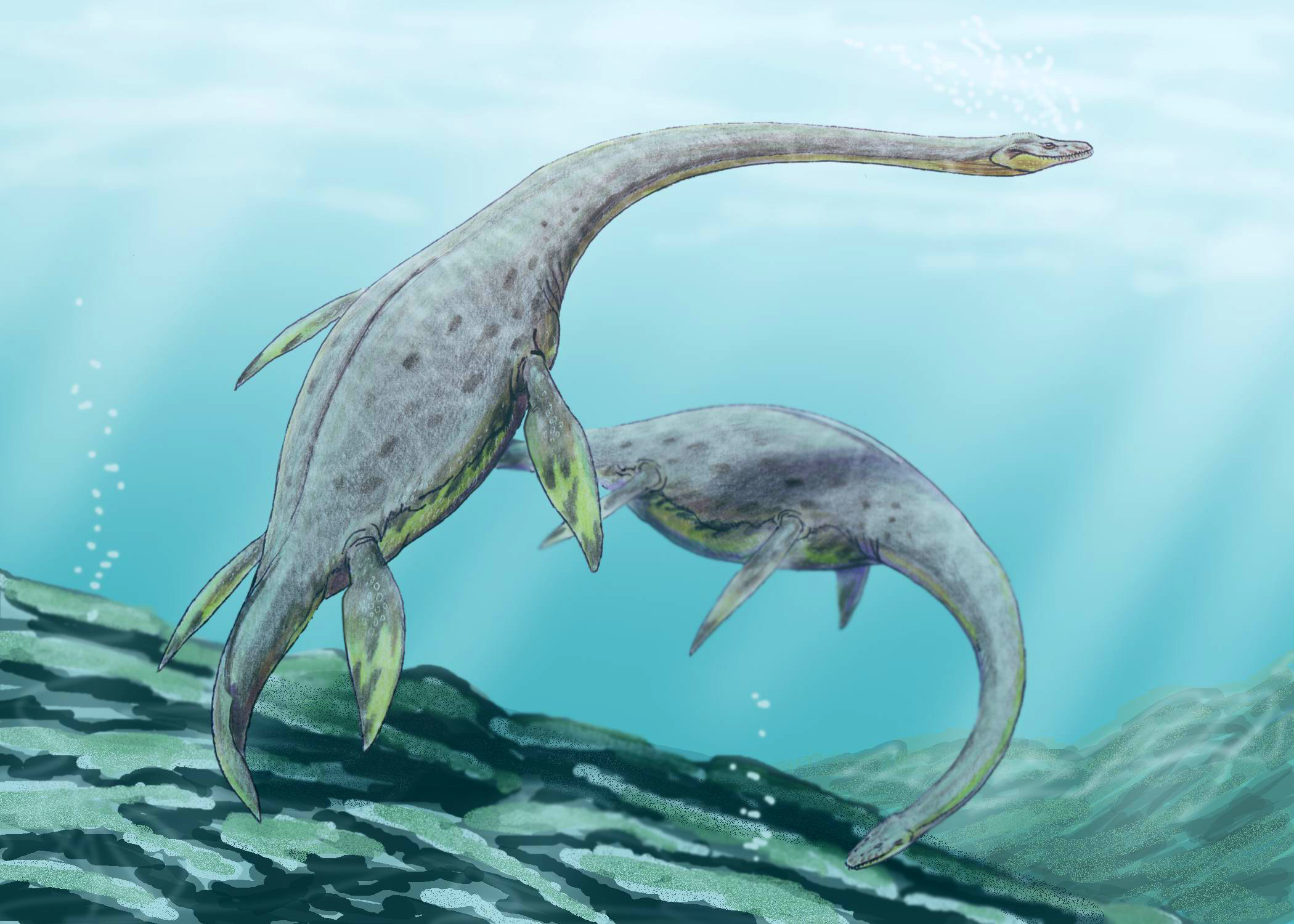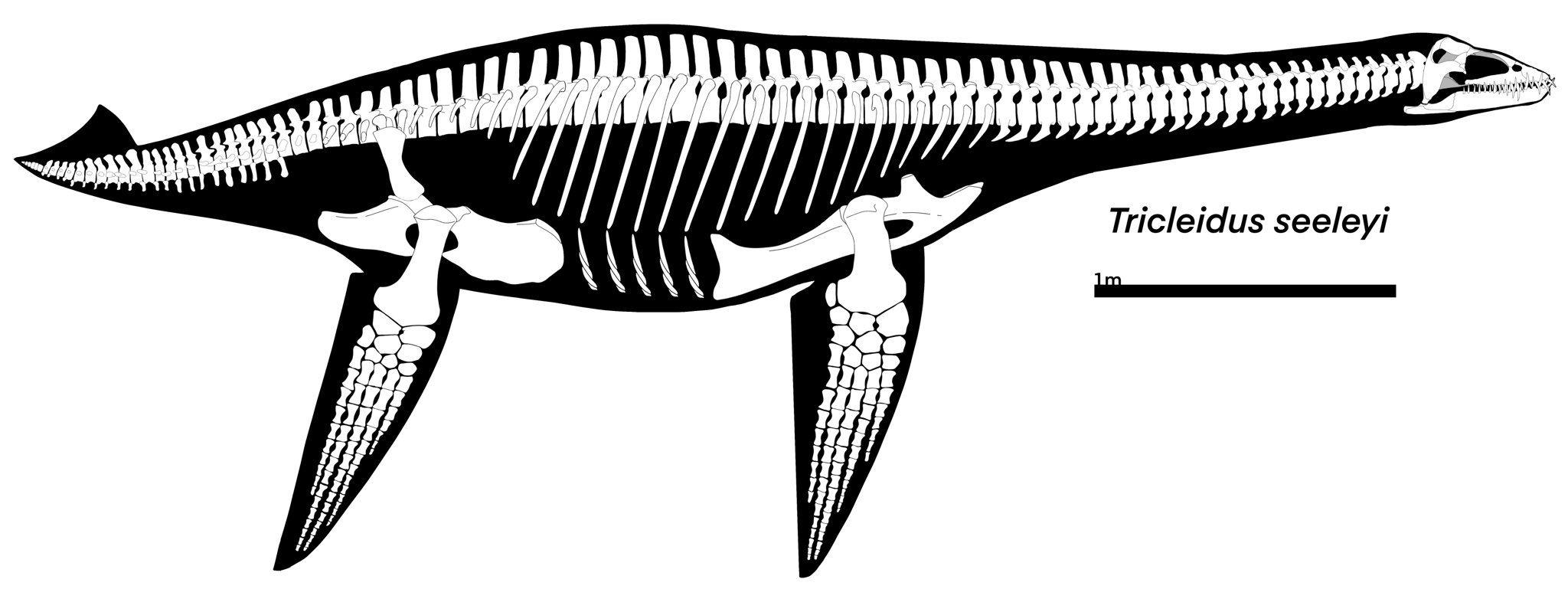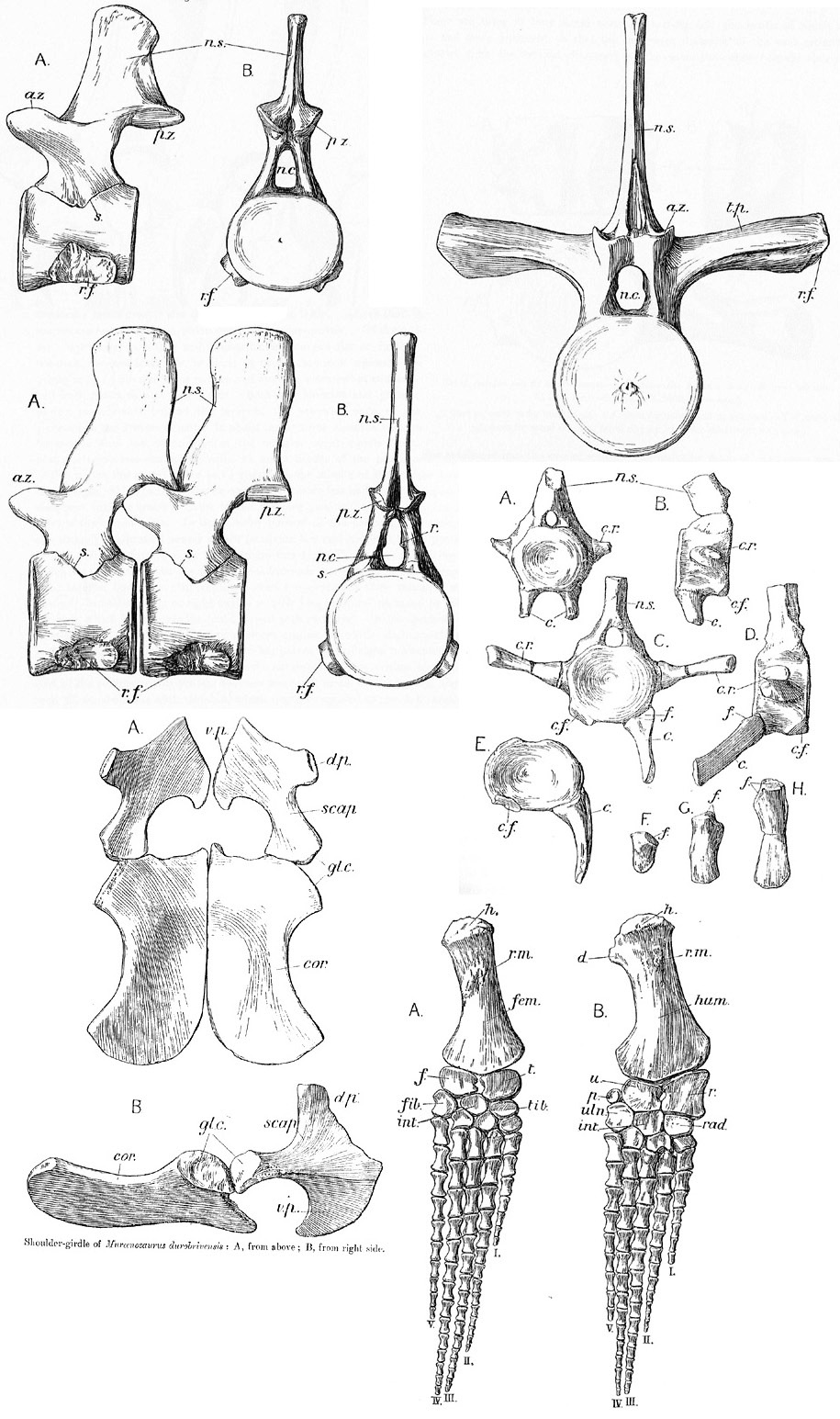|
Cryptoclididae
Cryptoclididae is a family (biology), family of medium-sized plesiosaurs that existed from the Middle Jurassic to the Early Cretaceous. They had long necks, broad and short skulls and densely packed teeth. They fed on small soft-bodied preys such as small fish and crustaceans. The earliest members of the family appeared during the early Bajocian, and they represented the dominant group of long-necked plesiosaurs during the latter half of the Jurassic. Classification In 2010, two supposed late Cretaceous members of the group were reclassified as other kinds of plesiosauroids. ''Kaiwhekea'' was reclassified to Leptocleididae, and ''Aristonectes'' was transferred to Elasmosauridae. Cladogram based on Ketchum and Benson (2010): References External links palaeos.com Cryptoclidids, Jurassic plesiosaurs Cretaceous plesiosaurs Callovian first appearances Late Cretaceous extinctions Prehistoric reptile families {{Jurassic-reptile-stub ... [...More Info...] [...Related Items...] OR: [Wikipedia] [Google] [Baidu] |
Elasmosauridae
Elasmosauridae is an extinct family of plesiosaurs, often called elasmosaurs. They had the longest necks of the plesiosaurs and existed from the Hauterivian to the Maastrichtian stages of the Cretaceous, and represented one of the two groups of plesiosaurs present at the end of the Cretaceous alongside Polycotylidae. Their diet mainly consisted of crustaceans and molluscs. Description The earliest elasmosaurids were mid-sized, about . In the Late Cretaceous, elasmosaurids grew as large as , such as '' Styxosaurus'', ''Albertonectes'', and '' Thalassomedon''. Their necks were the longest of all the plesiosaurs, with anywhere between 32 and 76 (''Albertonectes'') cervical vertebrae. They weighed up to several tons. Classification Early three-family classification Though Cope had originally recognized ''Elasmosaurus'' as a plesiosaur, in an 1869 paper he placed it, with ''Cimoliasaurus'' and ''Crymocetus'', in a new order of sauropterygian reptiles. He named the group Streptos ... [...More Info...] [...Related Items...] OR: [Wikipedia] [Google] [Baidu] |
Cryptoclidids
Cryptoclididae is a family of medium-sized plesiosaurs that existed from the Middle Jurassic to the Early Cretaceous. They had long necks, broad and short skulls and densely packed teeth. They fed on small soft-bodied preys such as small fish and crustaceans. The earliest members of the family appeared during the early Bajocian, and they represented the dominant group of long-necked plesiosaurs during the latter half of the Jurassic. Classification In 2010, two supposed late Cretaceous members of the group were reclassified as other kinds of plesiosauroids. ''Kaiwhekea'' was reclassified to Leptocleididae, and ''Aristonectes'' was transferred to Elasmosauridae. Cladogram A cladogram (from Greek ''clados'' "branch" and ''gramma'' "character") is a diagram used in cladistics to show relations among organisms. A cladogram is not, however, an evolutionary tree because it does not show how ancestors are related to d ... based on Ketchum and Benson (2010): References External ... [...More Info...] [...Related Items...] OR: [Wikipedia] [Google] [Baidu] |
Tatenectes
''Tatenectes'' is a genus of cryptoclidid plesiosaur known from the Upper Jurassic of Wyoming. Its remains were recovered from the Redwater Shale Member of the Sundance Formation, and initially described as a new species of '' Cimoliosaurus'' by Wilbur Clinton Knight in 1900. It was reassigned to '' Tricleidus'' by Maurice G. Mehl in 1912 before being given its own genus by O'Keefe and Wahl in 2003. ''Tatenectes laramiensis'' is the type and only species of ''Tatenectes''. While the original specimen was lost, subsequent discoveries have revealed that ''Tatenectes'' was a very unusual plesiosaur. Its torso had a flattened, boxy cross-section and its gastralia (belly ribs) exhibit pachyostosis (thickening). The total length of ''Tatenectes'' has been estimated at . ''Tatenectes'' is related to '' Kimmerosaurus'', although their taxonomic placement has varied. They were once considered to be close relatives of ''Aristonectes'' in the family Cimoliasauridae or Aristonect ... [...More Info...] [...Related Items...] OR: [Wikipedia] [Google] [Baidu] |
Plesiosaur
The Plesiosauria (; Greek: πλησίος, ''plesios'', meaning "near to" and ''sauros'', meaning "lizard") or plesiosaurs are an order or clade of extinct Mesozoic marine reptiles, belonging to the Sauropterygia. Plesiosaurs first appeared in the latest Triassic Period, possibly in the Rhaetian stage, about 203 million years ago. They became especially common during the Jurassic Period, thriving until their disappearance due to the Cretaceous–Paleogene extinction event at the end of the Cretaceous Period, about 66 million years ago. They had a worldwide oceanic distribution, and some species at least partly inhabited freshwater environments. Plesiosaurs were among the first fossil reptiles discovered. In the beginning of the nineteenth century, scientists realised how distinctive their build was and they were named as a separate order in 1835. The first plesiosaurian genus, the eponymous ''Plesiosaurus'', was named in 1821. Since then, more than a hundred valid ... [...More Info...] [...Related Items...] OR: [Wikipedia] [Google] [Baidu] |
Abyssosaurus
''Abyssosaurus'' is an extinct genus of cryptoclidid plesiosaur known from the Early Cretaceous of Chuvash Republic, western Russia. It possessed a shortened skull, and it has been suggested that it primarily inhabited the bathyal zone. Discovery ''Abyssosaurus'' is known only from the holotype specimen, Museum of Chuvash Natural Historical Society (MChEIO) no. PM/1, a partial postcranial skeleton. The holotype was collected in Poretskii District of Chuvashia, near Mishukovo, dating to the late Hauterivian faunal stage of the Early Cretaceous, about 133-130 million years ago. The specimen was initially thought to occupy an intermediate position between the Late Jurassic ''Tatenectes'' and '' Kimmerosaurus'' and the Late Cretaceous ''Aristonectes'' and ''Kaiwhekea''. Berezin (2011) considered ''Abyssosaurus'' to represent the first reliable record of Aristonectidae in Russia. A large phylogenetic analysis performed by Roger Benson and Patrick Druckenmiller found it to be a ... [...More Info...] [...Related Items...] OR: [Wikipedia] [Google] [Baidu] |
Muraenosaurus L2
''Muraenosaurus'' (from the Latin "''Muraena''" meaning "eel" and "''Sauros''" meaning lizard) is an extinct genus of cryptoclidid plesiosaur reptile from the Oxford Clay of Southern England. The genus was given its name due to the eel-like appearance of the long neck and small head. ''Muraenosaurus'' grew up to in length and lived roughly between 160 Ma (million years ago) and 164 Ma in the Callovian of the middle Jurassic. Charles E. Leeds collected the first ''Muraenosaurus'' which was then described by H. G. Seeley.Seeley, HG. 1874. On ''Murænosaurus Leedsii'', a Plesiosaurian from the Oxford Clay. Part I. ''Quarterly Journal of the Geological Society'' 30: 197-208. The specimen may have suffered some damage due to the casual style of Charles Leeds’ collection. The first Muraenosaur was recovered with pieces missing from the skull and many of the caudal vertebrae absent. Because the animal was described from Charles Leeds’ collection it was given the name ''Muraenosaur ... [...More Info...] [...Related Items...] OR: [Wikipedia] [Google] [Baidu] |
Kimmerosaurus
''Kimmerosaurus'' ("lizard from Kimmeridge") is an extinct genus of plesiosaur from the family Cryptoclididae. ''Kimmerosaurus'' is most closely related to ''Tatenectes''. Discovery There are very few fossil remains of ''Kimmerosaurus'' known. In fact, nothing has been found to show what ''Kimmerosaurus'' may have looked like below the neck, although the atlas and the axis are similar to those of the plesiosaur ''Colymbosaurus''. It is this lack of any post-cranial fossils, and the bone similarities that has led to the belief that ''Kimmerosaurus'' fossils could be the missing head of ''Colymbosaurus'', a similar plesiosaur with no known skull fossils. The first part of the genus name of ''Kimmerosaurus'' comes from the location of the first ''Kimmerosaurus'' fossils, Kimmeridge Clay deposits of Dorset, England (these deposits are also the root word for the Kimmeridgian stage of the Jurassic period). The second part comes from the Greek word ('), "lizard". Description As ''K ... [...More Info...] [...Related Items...] OR: [Wikipedia] [Google] [Baidu] |
Tricleidus
''Tricleidus'' is an extinct genus of cryptoclidid plesiosaur known from only specimen (BMNH R3539) from the middle Jurassic of United Kingdom. It was first named by Andrews in 1909 and the type species is ''Tricleidus seeleyi''. It was a relatively medium-sized plesiosaur, measuring long and weighing . See also * List of plesiosaur genera * Timeline of plesiosaur research This timeline of plesiosaur research is a chronologically ordered list of important fossil discoveries, controversies of interpretation, taxonomic revisions, and cultural portrayals of plesiosaurs, an order of marine reptiles that flourished duri ... References Cryptoclidids Middle Jurassic plesiosaurs of Europe Fossil taxa described in 1909 Taxa named by Charles William Andrews Oxford Clay Sauropterygian genera {{plesiosaur-stub ... [...More Info...] [...Related Items...] OR: [Wikipedia] [Google] [Baidu] |
Muraenosaurus
''Muraenosaurus'' (from the Latin "'' Muraena''" meaning "eel" and "''Sauros''" meaning lizard) is an extinct genus of cryptoclidid plesiosaur reptile from the Oxford Clay of Southern England. The genus was given its name due to the eel-like appearance of the long neck and small head. ''Muraenosaurus'' grew up to in length and lived roughly between 160 Ma (million years ago) and 164 Ma in the Callovian of the middle Jurassic. Charles E. Leeds collected the first ''Muraenosaurus'' which was then described by H. G. Seeley.Seeley, HG. 1874. On ''Murænosaurus Leedsii'', a Plesiosaurian from the Oxford Clay. Part I. ''Quarterly Journal of the Geological Society'' 30: 197-208. The specimen may have suffered some damage due to the casual style of Charles Leeds’ collection. The first Muraenosaur was recovered with pieces missing from the skull and many of the caudal vertebrae absent. Because the animal was described from Charles Leeds’ collection it was given the name ''Muraeno ... [...More Info...] [...Related Items...] OR: [Wikipedia] [Google] [Baidu] |
Jurassic
The Jurassic ( ) is a Geological period, geologic period and System (stratigraphy), stratigraphic system that spanned from the end of the Triassic Period million years ago (Mya) to the beginning of the Cretaceous Period, approximately Mya. The Jurassic constitutes the middle period of the Mesozoic, Mesozoic Era and is named after the Jura Mountains, where limestone strata from the period were first identified. The start of the Jurassic was marked by the major Triassic–Jurassic extinction event, associated with the eruption of the Central Atlantic magmatic province, Central Atlantic Magmatic Province. The beginning of the Toarcian Stage started around 183 million years ago and is marked by an extinction event associated with widespread Anoxic event, oceanic anoxia, ocean acidification, and elevated temperatures likely caused by the eruption of the Karoo-Ferrar, Karoo-Ferrar large igneous provinces. The end of the Jurassic, however, has no clear boundary with the Cretaceous and i ... [...More Info...] [...Related Items...] OR: [Wikipedia] [Google] [Baidu] |
Ophthalmothule
''Opthalmothule'' (meaning "eye of the north"), was a cryptoclidid plesiosaur dating to the latest Volgian (around the Jurassic-Cretaceous boundary), found in the Slottsmøya Member Lagerstätte of the Agardhfjellet Formation in Spitsbergen. The type species is ''O. cryostea''. Description ''Opthalmothule'' was a medium-sized plesiosaur, measuring long. It was noted to have unusually large eye sockets, which suggests a paleobiological specialization, such as deep water and/or nocturnal hunting. Along with ''Abyssosaurus'', it is one of the youngest cryptoclidids known from boreal Boreal may refer to: Climatology and geography *Boreal (age), the first climatic phase of the Blytt-Sernander sequence of northern Europe, during the Holocene epoch *Boreal climate, a climate characterized by long winters and short, cool to mild ... regions. The holotype is known from skeletal material that includes a complete cranium and a partial mandible, a complete and articulated cervical v ... [...More Info...] [...Related Items...] OR: [Wikipedia] [Google] [Baidu] |
Jurassic Plesiosaurs
The Jurassic ( ) is a geologic period and stratigraphic system that spanned from the end of the Triassic Period million years ago (Mya) to the beginning of the Cretaceous Period, approximately Mya. The Jurassic constitutes the middle period of the Mesozoic Era and is named after the Jura Mountains, where limestone strata from the period were first identified. The start of the Jurassic was marked by the major Triassic–Jurassic extinction event, associated with the eruption of the Central Atlantic Magmatic Province. The beginning of the Toarcian Stage started around 183 million years ago and is marked by an extinction event associated with widespread oceanic anoxia, ocean acidification, and elevated temperatures likely caused by the eruption of the Karoo-Ferrar large igneous provinces. The end of the Jurassic, however, has no clear boundary with the Cretaceous and is the only boundary between geological periods to remain formally undefined. By the beginning of the Jurassic, t ... [...More Info...] [...Related Items...] OR: [Wikipedia] [Google] [Baidu] |








